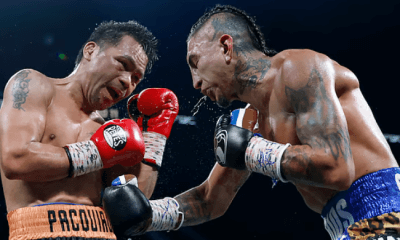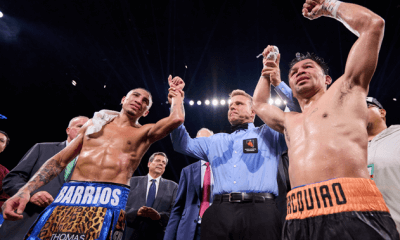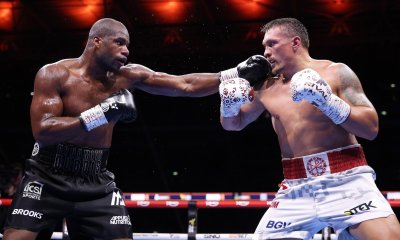Featured Articles
`NO MAS’ FIGHT SHOWED EVERY FIGHTER HARBORS A FEAR OF SOMETHING
So many fighters say the same thing. “I’m ready to die if necessary,” they publicly pronounce, and some might even believe it. But while bravery is as much of a staple of winning boxing as talent, answering the bell against even the most fearsome puncher is not the same as a soldier charging a machine-gun nest or engaging in hand-to-hand combat with an enemy who is actually trying to end his life, not just knock him out. A fighter’s fortitude and strength of character certainly are tested in the ring, but all the convenient comparisons to war go way too far. Boxing is a sport, and not one for the faint of heart, but it is never a matter of kill-or-be-killed. At least it shouldn’t be.
The truth is every fighter – probably every human being, for that matter – is afraid of something. The seemingly meekest individual is capable of extraordinary heroism, given the proper circumstances, and the most blustery bully can be exposed as a paper tiger if confronted by someone made of sterner stuff. The only thing that holds true in either case is the observers who stand off to the side critiquing the actions of the actually involved as being courageous or cowardly. And once the more odious label is applied, it can be extremely difficult to scrape off.
There might never have been a boxing match to fuel as much armchair psychoanalysis as the second of the three bouts that pitted Panamanian tough guy Roberto Duran against flashy American Sugar Ray Leonard. Nov. 25 marks the 35th anniversary of that curious bout in the Louisiana Superdome, in which Duran, who had been widely perceived as the fight game’s most implacable and relentless destroyer, abruptly threw up his hands late in the eighth round, muttered something to Mexican referee Octavio Meyran and began to walk away. It was a blatant act of surrender by the one man from whom no one would ever have expected it.
The bout soon came to be known, rather notoriously, as the “No Mas Fight,” a reference to the words in Spanish Duran supposedly had said to Meyran, which meant “No more,” although Duran to this day steadfastly insists he never said any such thing.
A disgraced Duran went home to find his palatial home vandalized, his most ardent fans holding him in contempt and the Panamanian government, which had assured him he would get to keep all $8 million of his purse because of his status as a “national hero,” now disposed to nullify that exemption and take $2 million off the top in taxes.
Fortunately, for the “Hands of Stone,” his legacy has been largely restored. He went on to fight 21 more years after “No Mas,” winning another two world championships along the way, and, who knows, he might still be fighting today, at 64, had he not been forced to retire after being in a bad car accident in October 2001, when he was 50. Several historians today rate him higher on various all-time pound-for-pound lists than Leonard, who lost their first fight (which was terrific) on a close but unanimous decision before Sugar Ray won parts two and three of the trilogy.
“In New Orleans, Duran became the story,” Leonard said of the “No Mas” fight that, even in victory, didn’t turn out the way he had anticipated. “All everyone talked about was him quitting. He got more attention for quitting than I did for winning the fight.”
There have been, of course, other fights – major ones, too – in which one of the principals quit, if only in a manner of speaking, rather than allowing himself to be knocked out or his humiliation to be extended to the final bell. But it is “No Mas” that has become a case study of the swirling emotions that can engulf even a great fighter when he finds himself in a place where bravado cannot rescue him from a dark place he never expected to be thrust into.
At the press conference to officially announce Duran-Leonard II, Duran dismissed Leonard and brashly predicted he would beat him much worse than he had in their first bout, which took place in Montreal five months earlier.
“I don’t like to see clowns in the ring,” he sneered with undisguised contempt. “I like to see boxers. To fight and beat me, you have to come into the ring and fight me, hard. (Leonard) goes into the ring and tries to imitate (Muhammad) Ali, but an imitator is a loser.”
Leonard imitated Ali all right, and pretty damn effectively, the most obvious example coming in the seventh round, when Sugar Ray wound up his right hand in windmill fashion, as if he was going to throw a bolo punch, before delivering a stinging left jab to Duran’s nose, causing the WBC welterweight champion’s eyes to water.
William Nack, writing in Sports Illustrated, described that moment as “the most painful blow of Duran’s life. It drew hooting laughter from the crowd and made Duran a public spectacle – a laughingstock.”
Perhaps ironically, Duran – who was not in the same tip-top shape he had been for the first fight with Leonard, having had to take off anywhere from 40 to 70 pounds in a relatively short time, depending on which version of the tale you choose to believe – believed that by simply walking away he was putting himself in a better light than if he had continued to be the target of Sugar Ray’s largely successful attempts to embarrass him.
“In Duran’s mind I think he expected that the crowd would condemn Leonard for having made a mockery of the fight, rather than him for quitting,” said veteran trainer Emanuel Steward, who was in the Superdome with his fighter, WBA welterweight titlist Thomas Hearns, to agitate for a unification showdown with the winner.
It was an egregious miscalculation.
“He quit out of humiliation and frustration,” Leonard told the late George Kimball, author of “Four Kings: Leonard, Hagler, Hearns, Duran and the Last Great Era of Boxing.” “It’s one of those things that happens to bullies. Duran threw his hands up without realizing the repercussions it would have on his legacy.”
Not surprisingly, Duran’s people quickly put up a smokescreen in which they blamed their guy’s disappointing performance, and eventual surrender, on stomach cramps and an injured right shoulder more than on Leonard’s superior foot and hand speed.
“If Duran had stomach cramps,” wrote Al Goldstein, the boxing writer for the Baltimore Sun, “it must have been his guts shrinking.”
Ed Schuyler Jr. of The Associated Press, cracking wise to his colleagues in the press room, said, “They’re checking Duran’s birth certificate back in Panama. They think now he may be a Guatemalan.”
To appreciate and understand the furor attendant to “No Mas,” it is necessary to go back to their first encounter, on June 20, 1980, at Montreal’s Stade Olympique, in the same city in which Leonard was the breakout, gold-medal-winning star of the Olympic boxing competition.
Perhaps Duran’s resentment of Leonard went from slow boil to volcanic eruption when it became apparent that he and his team had been snookered at the negotiating table by the Sugar man and his savvy attorney/adviser, Mike Trainer. Trainer had arranged for Leonard to receive the entire site fee and 80 percent of the closed-circuit and foreign TV sales, which wound up being nearly $10 million, by far eclipsing the previous high payday for a fighter, which was the $6.5 million Ali got for his third bout with Ken Norton. Duran, meanwhile, had signed quickly for $1.65 million, which was his biggest purse to that point but so much less than he might have received had he sought a more equitable division of the financial pie.
In any case, this was a fight in which it was virtually impossible to sit on the fence.
“The casting is perfect,” said Angelo Dundee, Leonard’s chief second. “You have Sugar Ray, the kid next door, the guy in the white hat, against Duran, the killer, the guy with the gunfighter’s eyes. It’s the kind of fight where you can’t be neutral.”
Duran played his part to the hilt, except that he wasn’t playing. He insulted Leonard from the get-go, and his constant disparagement of the Olympic poster boy had Leonard convinced that his best course of action would be to beat the mouthy Panamanian at his own game.
“He had that bully’s mentality,” Leonard said after he was handed his first loss as a pro. “He always tries to intimidate opponents. He challenged my manhood, and I wasn’t mature enough to know how to respond. All I could think about was retaliating.”
Despite facing Duran on the Panamanian’s terms, Leonard met fire with fire. He barely lost on points, coming up short by margins of 146-144, 148-147 and 145-144 on the judges’ scorecards. And it wasn’t long before he concluded that he would fare much better with a revised fight plan, particularly in light of the nonstop celebrating engaged in by Duran, who now saw himself as invincible, or at least something close to it. So Leonard and Trainer pressed for a quick rematch, offering Duran that $8 million, but only if he agreed to the November date.
“I knew Duran was overweight and partying big time,” Leonard said. “I’ve done some partying myself, but I knew when to cut it out. I said to Mike, `Let’s do it now, as soon as possible.’ In retrospect, it was pretty clever of me.’”
So, how does “No Mas” look now, 35 years down the road? Should Duran have insisted on more time to get his body back in peak condition, and if so, would the outcome have been different? Might it have been preferable to chase after Leonard, slowly being beaten down and then stopped?
Duran, in an interview with Nack three years after “No Mas,” continued to give Leonard something less than full credit for winning while absolving himself of at least some of the blame.
“Leonard knew I had nothing,” Duran said. “He was running and clowning because he knew I couldn’t do anything. I wasn’t going to let myself get knocked out and look ridiculous in the ring.”
It is a mindset that is hardly unique to Duran. A two-time former heavyweight champion who had won a silver medal at the 1992 Barcelona Olympics as a 165-pounder, Chris Byrd made a career of flummoxing larger heavyweights who would have preferred being pounded into submission by someone more like them than to be shown up by the flitting Byrd.
“It’s called `getting clowned,’” Byrd said before his Dec. 14, 2002, bout with Evander Holyfield for the vacant IBF heavyweight title, which Byrd won by unanimous decision. “Nobody wants to get clowned. They’d rather get knocked out than to get frustrated and embarrassed at the same time. But I’ve been doing that to people for a long time … since I was a kid. I pride myself on that. I kind of make guys look foolish, particularly heavyweights since they’re a lot slower.”
Which brings us back to the subject of fear in the ring, in all its various forms. There is the most obvious application, which is the fear of being beaten bloody, the kind that virtually paralyzed some of the opponents faced by such devastating punchers as Sonny Liston, George Foreman and Mike Tyson. And there is the more subtle form of apprehension and dismay, the kind perhaps displayed by Tyson – a fighter who, by the way, has always looked upon Duran as a role model – when he got himself disqualified in his rematch with Holyfield, by twice chomping on Evander’s ears, a form of submission as much as Duran turning his back on Leonard, at least in the opinion of noted boxing commentator and former Tyson trainer Teddy Atlas.
One of the more gentlemanly fighters ever to have achieved significant success, the late two-time former heavyweight champion Floyd Patterson, was as far removed from Duran, both stylistically and personally, as anyone could be. But Patterson gave one of the most honest and insightful interviews ever to author Gay Talese in the March 1964 edition of Esquire magazine, in which Patterson spoke of the near-terror that gripped him before both of his clashes with Liston, who won each by first-round knockout.
“Oh, I would give up anything to just be able to work with Liston, to box with him somewhere where nobody would see us, and to see if I could get past three minutes with him,” Patterson told Talese. “I know I can do better. I’m not talking about a rematch. Who would pay a nickel for another Patterson-Liston fight? I know I wouldn’t. But all I want to do is get past the first round.
“It’s not a bad feeling when you’re knocked out,” Patterson said a bit further down in the article. “It’s a good feeling, actually. It’s not painful, just a sharp grogginess; you’re on a pleasant cloud. But then this good feeling leaves you. And what follows is a hurt, a confused hurt – not a physical hurt. It’s a hurt combined with anger; it’s a what-will-people-think hurt. All you want then is a hatch door in the middle of the ring, a hatch door that will open and let you fall through and land in your dressing room.”
For his first fight with Liston, Patterson – who had a sinking sensation he would lose in pretty much the manner that he did – brought a false beard, false mustache, hat and glasses to his dressing room so that he could slip away as quietly and anonymously as possible.
“You must wonder what makes a man do things like this,” Patterson told Talese. “Well, I wonder, too. And the answer is, I don’t know. But I think within me, within every human being, there is a certain weakness. It is a weakness that expresses itself more when you’re alone. And I have figured out that part of the reason I do the things I do is because … I am a coward. You see it when a fighter loses.”
So, Patterson was asked, could the menacing Liston be a coward as well?
“That remains to be seen,” he replied. “We’ll find out what he’s like after somebody beats him, how he takes it. It’s easy to do anything in victory. It’s in defeat that a man reveals himself.”
On Feb. 25, 1964, the big, ugly bear, Liston, got clowned big-time in his first meeting with Cassius Clay and quit on his stool after the sixth round, citing an injured shoulder which in retrospect appears as dubious an excuse as was to Roberto Duran’s stomach cramps.
The fights go on, and sometimes the hardest struggle is the one that a fighter wages within himself to tame the beast that gnaws at his insides when things aren’t going his way and the prospect for a turnaround are dimming fast. It calls to mind something written by Ernest Hemingway, not necessarily about boxing, although it very well might have been.
“The world breaks everyone, and afterward, some are strong at the broken places,” surmised Hemingway, who also noted that, “Man is not made for defeat. A man can be destroyed but not defeated.” It is a point of view that would seem to be the basis of extensive debate.
“Papa” did not weigh in on the conundrum of a fighter being clowned. You’d have to think it would have been the basis for a terrific novel, though.
-

 Featured Articles3 weeks ago
Featured Articles3 weeks agoThe Hauser Report: Zayas-Garcia, Pacquiao, Usyk, and the NYSAC
-

 Featured Articles2 weeks ago
Featured Articles2 weeks agoOscar Duarte and Regis Prograis Prevail on an Action-Packed Fight Card in Chicago
-

 Featured Articles1 week ago
Featured Articles1 week agoThe Hauser Report: Cinematic and Literary Notes
-

 Book Review3 days ago
Book Review3 days agoMark Kriegel’s New Book About Mike Tyson is a Must-Read
-

 Featured Articles4 weeks ago
Featured Articles4 weeks agoManny Pacquiao and Mario Barrios Fight to a Draw; Fundora stops Tim Tszyu
-

 Featured Articles3 weeks ago
Featured Articles3 weeks agoArne’s Almanac: Pacquiao-Barrios Redux
-

 Featured Articles2 weeks ago
Featured Articles2 weeks agoRemembering Dwight Muhammad Qawi (1953-2025) and his Triumphant Return to Prison
-

 Featured Articles4 weeks ago
Featured Articles4 weeks agoOleksandr Usyk Continues to Amaze; KOs Daniel Dubois in 5 One-Sided Rounds













